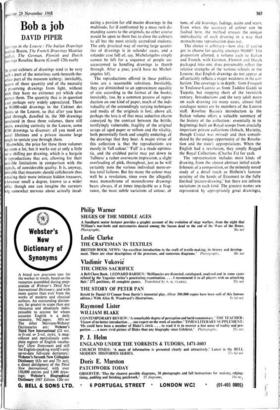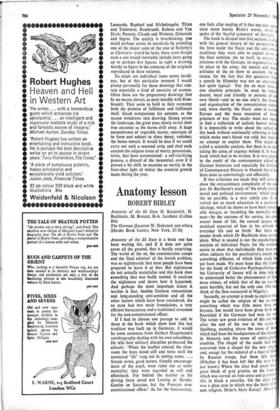Bob a job
DAVID PIPER
Drawings in the Louvre : The Italian Drawings Baseline Bacou, The French Drawings Maurice sirullaz, The German, Flemish and Dutch Dwings Roseline Bacou (Cassell 120s each) The great cabinets of drawings tend to be very much a part of the notorious sunk-beneath-the- carfare part of the museum iceberg: inevitably, cause of sheer quantity and of the necessity preserving drawings from light, without which they have no existence yet which also kstroys them. The quantity that is in question not perhaps very widely appreciated. There are 90,000-odd drawings in the Cabinet des Dessins at the Louvre, so that after-you have iafed through, dawdled in, the 300 drawings reproduced in these three volumes, there still main, awaiting curiosity in the Louvre, some ,700 drawings to discover; all you need are veral lifetimes and a private income large ()ugh to sustain you through them.
Meanwhile, the price for these three volumes y seem a lot, but it works out at only a little vet a shilling per drawing, which is a bargain tr reproductions that are, allowing for their vitable limitations in comparison with the ginals, of considerable quality. It is, anyway, irable that museums should collaborate thus making their more intimate hidden treasures, however small a degree, known to a wider bile; though one can imagine the curators lug somewhat nervous about actually incul-
eating a passion-for old master drawings in the multitude, for if confronted by a mass rush de- manding access to the originals, no other course Nould be open to them but to close the cabinets to all but the most strictly accredited students. The only practical way of storing large quanti- ties of drawings is in solander cases, and a solander case full of, say, Michelangelos simply cannot be left for a sequence of people un- accustomed to handling drawings to thumb through. After a year, you'd have no Michel- angelos left.
The reproductions offered in these publica- tions are a reasonable substitute. Inevitably, they are diminished to an approximate equality of size according to the format of the books; inevitably, too, by a common process of repro- duction on one kind of paper, much of the indi- viduality of the astoundingly varying techniques and media of the originals is lost; above all, perhaps the loss is of that most seductive charm conveyed by the contrast between the brittle, terrifyingly vulnerable, fragility of the original scraps of aged paper or vellum and the vitality, both perennially fresh and toughly enduring, of the drawings that they bear. A major virtue of this collection is that the reproductions are mostly'in 'full colour.' Full' is a shade optimis- tic, and the crabbed purist may put down to `fullness' a rather overwarm impression, a slight- overloading of pink, throughout, just as he will certainly note the various individual more-or- less total failures. But for many the colour may well be a revelation, since even the allegedly most monochrome of monochrome drawings bears always, if at times impalpable as a frag- rance, the most subtle variations of colour, of
tone, of old bruisings, fadings, stains and scars. Even when the accuracy of colour can be faulted here, the method stresses the unique individuality of each drawing in a way that monochrome reproduction does not.
The choice is arbitrary—how else, if you've got to choose for quality amongst 90,000? The proportion allotted, a volume each to Italian and French, with German, Flemish and Dutch packaged into one, does presumably reflect the relative strengths of the various schools in the Louvre; that English drawings do not appear at all certainly reflects a major weakness in the col- lection. The coverage is in depth : from Fouquet to Toulouse-Lautrec as from Taddeo Gaddi to Tiepolo, but stopping short of the twentieth century. Introductions and the very adult notes on each drawing (in many cases, almost full catalogue notes) are by members of the LouVre staff. Roseline Bacou's introduction to the Italian volume offers a valuable summary of the history of the collection: essentially id its beginnings built on Royal scoops from crucially important private collections (Jabach, Mariette, though Crozat was missed) and then consoli- dated by the unique opportunity of the Revolu- tion and the state's appropriations. When the English had a revolution, they simply flogged the Royal Collections (Charles I's) for cash.
The representation includes most kinds of drawing, from the almost abstract initial estab- lishment of a composition, or the minutely noted study of a detail (such as Holbein's famous scrutiny of the hands of Erasmus) to the fully finished 'picture-drawing,' but there are infinite variations in each kind. The greatest names are represented by appropriately great drawings:, Leonardo, Raphael and Michelangelo; Titian and Tintoretto; Rembrandt, Rubens and Van Dyck; Poussin, Claude and Watteau, Delacroix and Ingres. The quality is breathtaking; you could perhaps assess its standards by attending one of the major sales of the year at Sotheby's or Christie's—you'd be lucky there, even though such a sale would inevitably include items going up to perhaps five figures, to sight a drawing worthy to figure in the company of the originals reproduced in these volumes.
To single out individual items seems invidi- ous, but at this particular moment I would plump personally for those drawings that con- tain especially a kind of necessity of essence. Often these are the preparatory drawings (but by no means always, as most notably with Rem- brandt). They seem to hold in their economy both the promise of fulfilment and fulfilment itself. Good companions for autumn, as the season withdraws into drawing. Strung across the landscape, the great trees slowly reveal their true anatomy as the leaves drift away. A huge encumbrance of vegetable matter, uncertain of its form and subject to slimy decay, vanishes; the bones remain. It would be nice if we 'could carry out such a seasonal strip, and shed each autumn the adipose tissue of worry, possessions, trivia, that have accumulated: a self-clarifying process, a discard of the inessential, even if it proved a bit chill, to examine so starkly in the frost-clear light of winter the essential growth made during the year.







































 Previous page
Previous page